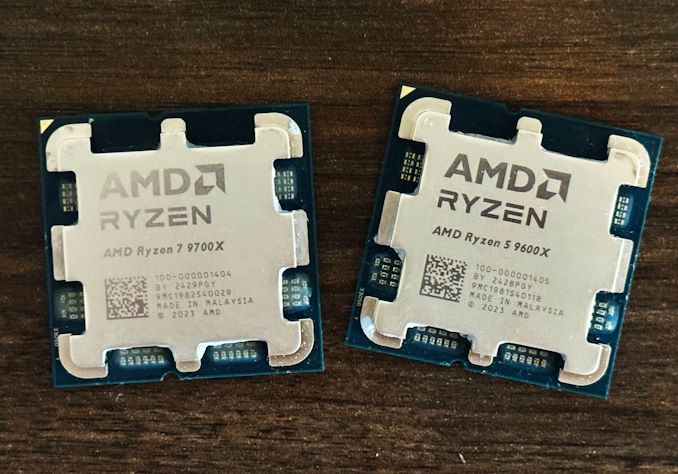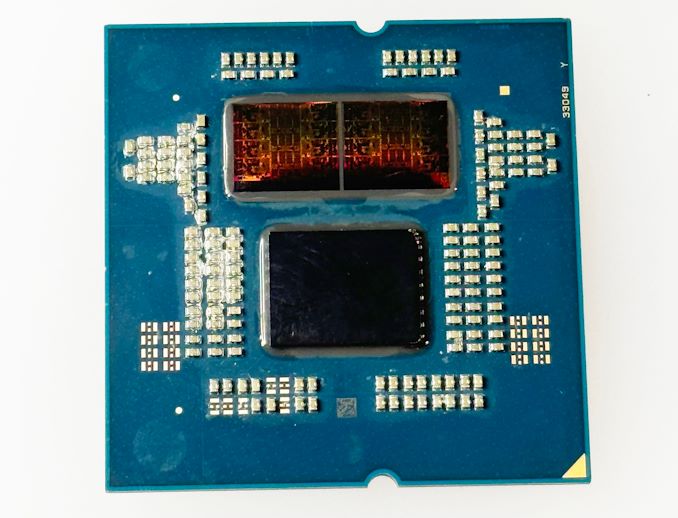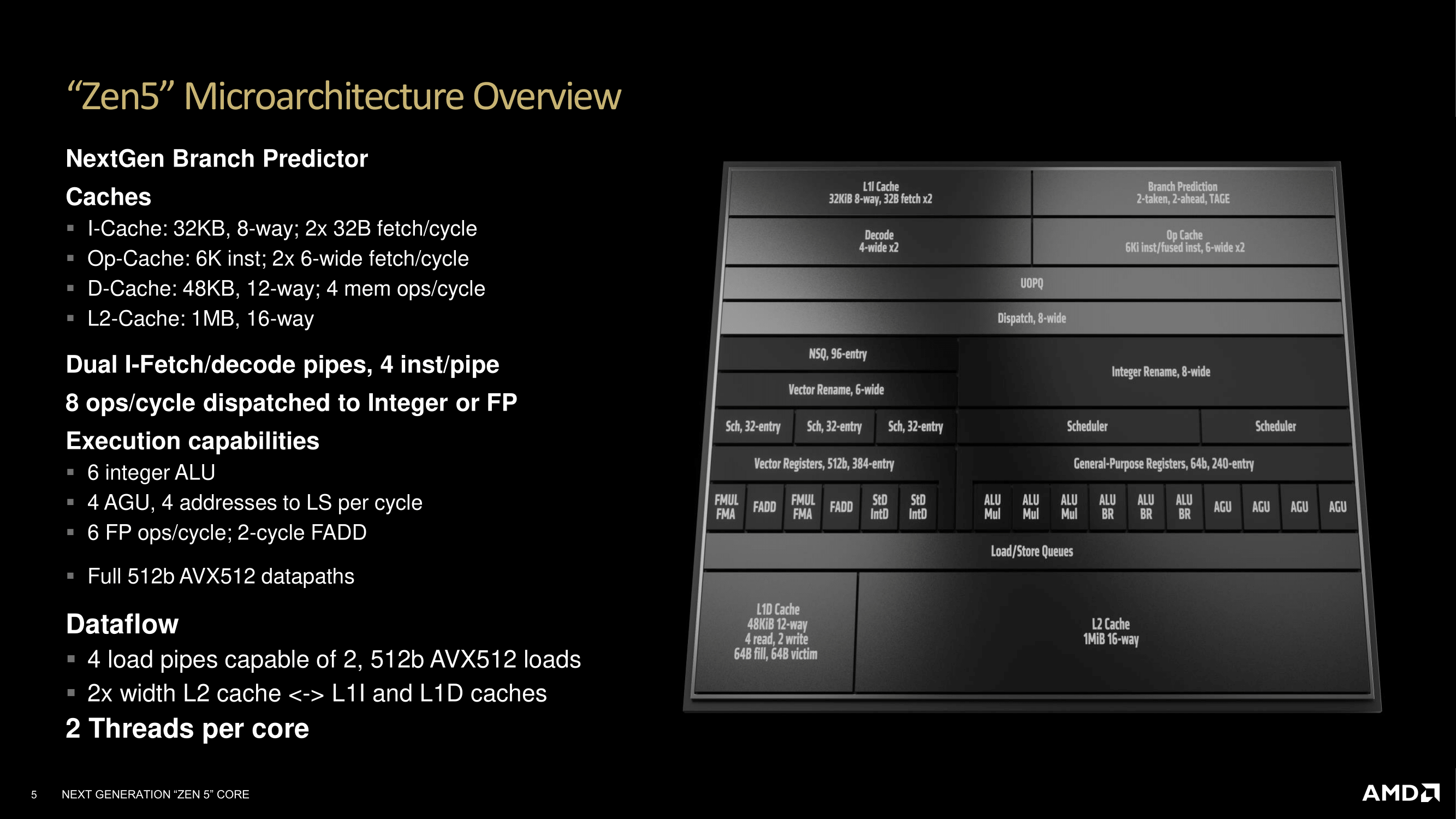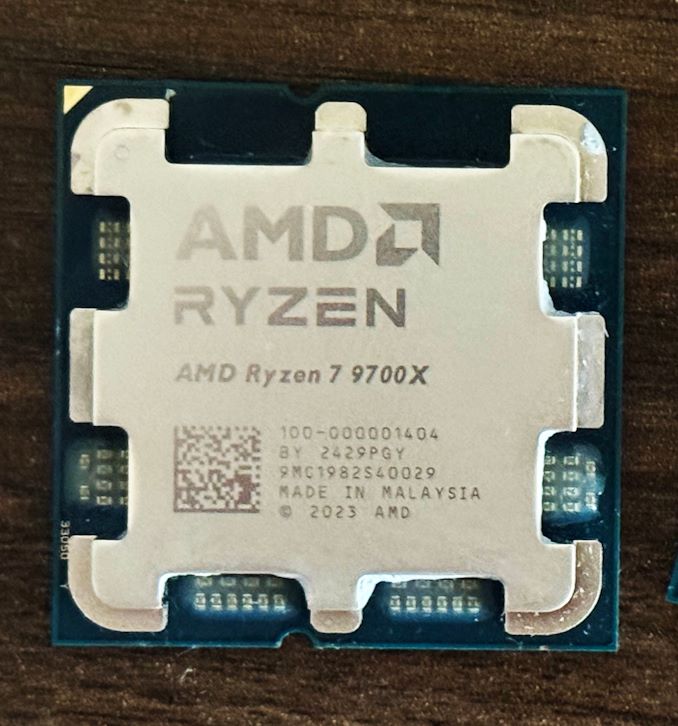The AMD Ryzen 7 9700X and Ryzen 5 9600X Review: Zen 5 is Alive
by Gavin Bonshor on August 7, 2024 9:00 AM EST
Last month, AMD launched their first processors using the Zen 5 microarchitecture for the mobile market via their Ryzen AI 300 series. Typically, with AMD Ryzen launches, we usually see the desktop parts come first, with the flagship model and then the mobile coming after. This time around, AMD has changed the dynamic of their release schedule with Zen 5 by launching the mobile chips first, which includes the Ryen AI 9 HX 370, which we reviewed last month. Today, Zen 5 on desktop has its turn, as AMD has launched two mid-range desktop processors, the Ryzen 7 9700X and the Ryzen 5 9600X.
AMD has launched two of the four announced Ryzen 9000 series processors today. The entry-level model is the Ryzen 5 9600X, a 6C/12T part with full-sized Zen 5 cores that can boost up to 5.4 GHz out of the box. The other model launched today is the Ryzen 7 9700X, which also features 8C/16T of Zen 5 and a boost clock speed of up to 5.5 GHz.
As part of AMD's push on platform longevity, the Ryzen 9000 series shares the same AM5 socket as its predecessor, meaning users can use X670E/X670 and B650E/B650 motherboards with a firmware update. We expected to see the newer X870X motherboards come with the Ryzen 9000 release, but unfortunately, these have been delayed.
So now we have Zen 5 in the form of the Ryzen 9000 series finally hitting the desktop, sans the top two SKUs, the Ryzen 9 9950X and Ryzen 9 9900X, which are coming later, it's time to see how much of an improvement Zen 5 is over Zen 4, not just in single-threaded but also multi-threaded workloads as AMD has promised up to an uplift of 16% IPC on average. The Ryzen 7 9700X and Ryzen 5 9600X have a TDP of 65 W, which we see as more aligned with the non-X SKUs, so it will be interesting to see how Zen 5 performs in both performance and efficiency.
AMD Ryzen 7 9700X and Ryzen 5 9600X: Zen 5 For Desktop
Over the last couple of months, since AMD unveiled Zen 5 at Computex 2024, we've penned quite several column inches around the latest Zen 5 microarchitecture. AMD has made some interesting upgrades to their Ryzen processors for Zen 5 when combined with Zen 4, at least in the design of the cores. Interestingly, AMD is using the same IOD that we saw in Zen 4, with the only part of the Ryzen 9000 series getting an upgrade via the cores themselves, with up to two core complexes (Ryzen 9) featuring the new Zen 5 cores. The I/O die itself is manufactured by TSMC on their 6 nm node.
The Zen 5 microarchitecture improves upon multiple areas over Zen 4, especially in things such as caching and instruction-fetch capabilities. The Zen 5 architecture doubles the L2 cache size to 1 MB per core over Zen 4, upgrading the I-Cache to 32 KB and the D-Cache to 48 KB. Dual I-Fetch/decode pipes allow the cores to handle more instructions per cycle than the single fetch/decode pipe featured on Zen 4. The Execution Units on Zen 5 also get a bit of a buff, as Zen 5 comes with 6 Integer ALUs and 6 FP operations per cycle versus the more minor execution capabilities of Zen 4. This way, the throughput and general efficiency of the chip are improved.
Zen 5 is also optimized for stronger data flow in general and power efficiency compared to Zen 4. It gets upgraded to 4 load pipes for 512b AVX-512 workloads, as well as wider L2 cache paths that should be able to handle data better. AMD has also taken a bit of a different approach with AVX-512 instructions for Zen 4, including a single full AVX-512 data path; however, two 256-bit paths come with Zen 4 and opt to "double pump" the data, which isn't as efficient. There is also the continued inclusion of Simultaneous Multi-Threading (SMT), which means Zen 5 has two threads per core for improving multi-threaded performance.
Another thing to note is that Zen 5 processors are manufactured using TSMC's N4P node. TSMC states that this offers significant improvements over the 5nm node used in Zen 4. Although TSMC's base 4nm node (N4) is not much better than 5nm, the N4P node reportedly shows plenty of gains in comparison. TSMC states that the N4P node delivers an 11% increase in performance, a 22% gain in power efficiency, and a 6% boost in transistor density compared to the N5 (5 nm) node. Thanks to more EUV layers, the N4P process also cuts production costs by using around 6%, with fewer masks used in the production stage.
AMD's Zen 5 die can support up to 16 cores, including 1 MB L2 cache per core, with up to 8C/16T of compute cores and 32 MB L3 cache per CCD. The integrated GPU uses 1 WGP and 2 CUs based on the RDNA 2 architecture, which remains unchanged over Zen 4. It also has two 32B/cycle ports for effective data management that offer basic integrated graphics support for users without a discrete graphics card. Other implementations on the Granite Ridge SoC include specific accelerators and micro-controllers for video encoding/decoding, audio co-processors, and display controllers with support for up to 4 concurrent displays.
The IO side supports 128-bit DDR5 memory at 5600 MT/s (DDR5-5600) and 28 x PCIe Gen 5 lanes, meaning it can support one full-length PCIe 5.0 slot at x16 or two full-length slots at x8/x8. It also gives additional PCIe headroom for PCIe 5.0 x4 M.2 SSDs. The SoC also supports multiple USB ports, including up to three USB 3.3 Type-C, one USB 3.2 Gen2 Type-A, and one USB2. We are starting to see a more holistic shift from the older USB standards, such as USB 2, although these are backward compatible throughout the different standards.
| AMD Ryzen 9000 Series Processors Zen 5 Microarchitecture (Granite Ridge) |
|||||||
| AnandTech | Cores / Threads |
Base Freq |
Turbo Freq |
L2 Cache |
L3 Cache |
TDP | MSRP |
| Ryzen 9 9950X | 16C / 32T | 4.3GHz | 5.7GHz | 16 MB | 64 MB | 170 W | $649 |
| Ryzen 9 9900X | 12C / 24T | 4.4GHz | 5.6GHz | 12 MB | 64 MB | 120 W | $499 |
| Ryzen 7 9700X | 8C / 16T | 3.8GHz | 5.5GHz | 8 MB | 32 MB | 65 W | $359 |
| Ryzen 5 9600X | 6C / 12T | 3.9GHz | 5.4GHz | 6 MB | 32 MB | 65 W | $279 |
Looking at the Ryzen 9000 stack as it currently stands, AMD has announced four SKUs in total so far. The flagship SKU, the Ryzen 9 9950X, has 16 cores, a max boost clock of up to 5.7 GHz, and 80 MB of cache, which is split between 64 MB for the L3 and 16 MB for the L2 (1 MB per core of L2). It also has a 170 W TDP, which mirrors the previous Ryzen 9 7950X. This is where the rest of the stack differs from the Ryzen 7000 SKUs, and each of the new Zen 5 chips replaced differs.
The Ryzen 9 9900X is a 12C/24T part, which boosts up to 5.6 GHz, which coincidentally is the same boost frequency the Ryzen 9 7900X it replaces comes with, too. Aside from the change in architecture to Zen 5 from Zen 4, the biggest difference in paper specifications is that the new Ryzen 9 9900X has a TDP of just 120 W, down from the 170 W from the previous SKU.

AMD Ryzen 9000 series die shot with 2 x CCXs (Ryzen 9)
Moving down the stack and onto the two processors we're reviewing today, the Ryzen 7 9700X, which comes with 8 cores, a max boost clock of up to 5.5 GHz, 32 MB of L3 cache, and a 65W TDP. In contrast, the Ryzen 5 9600X has just 6 cores, a max boost clock of up to 5.4 GHz, and 32 MB of L3 cache. Also, it has a 65 W TDP. Still, both their predecessors, the Ryzen 7 7700X (8C/16T Zen 4) and the Ryzen 5 7600X (6C/12T Zen 4), have a higher 105 W TDP.
This is a testament to AMD's focus and commitment to delivering power efficiency. With close to the same boost clocks as their Zen 4 counterparts, Zen 5 and Ryzen 9000 do things with a lower voltage/frequency (V/F) curve. This shows that Zen 5 is seemingly more efficient than Zen 4, but AMD has also bumped memory support up to DDR5-5600, up from DDR5-5200 on Ryzen 7000.
| AMD AM5 Chipset Comparison | |||||
| Feature | X870E | X870 | X670E | X670 | B650E |
| CPU PCIe (PCIe) | 5.0 | 5.0 | 5.0 | 4.0 | 5.0 |
| CPU PCIe (M.2 Slots) | At Least 1 PCIe 5.0 Slot | ||||
| Total CPU PCIe Lanes | 24 | ||||
| Chipset PCIe Lanes (Max) | 4.0: 12 3.0: 8 |
4.0: 8 3.0: 4 |
4.0: 12 3.0: 8 |
4.0: 8 3.0: 4 |
|
| USB4 | Mandatory (Discrete, Consumes 4 Chipset PCie 4.0 Lanes) |
Optional | |||
| SATA Ports (Max) | 8 | 4 | 8 | 8 | 4 |
| DDR5 Support | Quad Channel (128-bit bus) | ||||
| Wi-Fi | Wi-Fi 7 (Discrete) | Wi-Fi 6E (Discrete) | |||
| CPU Overclocking Support | Yes | ||||
| Memory Overclocking Support | Yes | ||||
| # of Chips | 2 | 1 | 2 | 2 | 1 |
| Silicon | ASMedia Promontory 21 | ||||
| Available | Expected Sept. 2024 | Expected Sept. 2024 | Sept. 2022 | Sept. 2022 | Oct. 2022 |
Although the Ryzen 9000 uses the same AM5 socket as the previous Ryzen 7000 series, motherboard vendors have been readying new motherboards based on the X870E and X870 chipsets. All of the AM5 socket motherboards that are either currently on the market or due to be released with the X870E/X870 chipsets use the same ASMedia Promontory 21 chipset at their heart. The only real difference is in the feature sets, and newer boards utilize new controllers that previously weren't available at the time.
Notable additions with X870E/X870 include USB 4.0 support, which will be ubiquitous on all X870(E) boards, where it was previously only optional for X670(E) series boards. X870(E) boards will also herald in Wi-Fi 7 support, although that's leaping from 6E with the 600 series with at least one PCIe 5.0 NVMe slot continuing to be a mandatory inclusion. AMD also notes that motherboards based on both platforms "feature 44 total PCIe lanes," which would break down to 24 lanes from the CPU and another 20 lanes from the chipset.
That being said, if users already have an existing AM5 motherboard, there's no need to upgrade unless the temptation of features like Wi-Fi 7 is pretty much the biggest difference on most of the newer motherboards. The other caveat with X870E and X870 is that there's no official date for these models to hit the shelves. We know these should be expected sometime in September, which we got from a reliable source from a big motherboard manufacturer.
Regarding pricing, the AMD Ryzen 7 9700X has an MSRP of $359, which is actually $40 cheaper than its predecessor, the Ryzen 7 7700X, which launched in September 2022 for $399. The same can be said about the Ryzen 5 7600X, which debuts at $279, which is $20 cheaper than the Ryzen 5 7600X did around this time 2 years ago at launch. AMD is coming in aggressive with its pricing on Zen 5. While both these chips are aimed firmly at the more affordable end of the market, it's time to see how they compete with their Ryzen 7000 (Zen 4) counterparts, as well as Intel's Raptor Lake (14th Gen) chips such as the Core i5-14600K, among others we've tested.
How does Zen 5 for desktop compare to Zen 4 and Intel's offerings? It's time to find out how Zen 5 hangs.













70 Comments
View All Comments
Golgatha777 - Wednesday, August 7, 2024 - link
Thanks for the review. I personally would have liked to see a 7800X3D in the benchmarks. Also, I would have omitted 720p and replaced it with 1440p gaming benchmarks. 1080p is perfectly fine for a synthetic benchmark to see which CPU is faster overall and a lot of gamers run 1440p.kpb321 - Wednesday, August 7, 2024 - link
Agreed. The 7800X3D should be very close in price to the 9700X so having both in the gaming charts would be pretty nice. Offhand I assume it will be a mix. For standard game the 9700x should have a small lead due to the Zen 5 improvements. For things that are cache sensitive that will make the 7800X3D more competitive or even faster.heffeque - Wednesday, August 7, 2024 - link
It doesn't make sense.The 7800X3D should be compared to the 9800X3D (which will come in a few months).
Trackster11230 - Wednesday, August 7, 2024 - link
It makes sense to compare the 7800X3D to the 9700X due to price, and I'm sure it'll be compared against the 9800X3D when it comes out too. These aren't mutually exclusive.Klober - Wednesday, August 7, 2024 - link
Seriously? Did none of you pay attention to the charts? There's clearly a 7800X3D in all but 2 of the charts on this page alone. I could maybe see an argument made for the 7900X3D (coincidentally, the CPU I have which I why I noted it's missing) but not the 7800X3D.Trackster11230 - Wednesday, August 7, 2024 - link
Yes, I see it in the charts, hence my comment about it making sense being in here. It's similar in price to the 9700X, so it makes sense to compare from that metric. What's so difficult to understand?I could make an argument too that an 8c/16t CPU makes more sense to compare to than the 7900X3D with 12c/24t.
boozed - Wednesday, August 7, 2024 - link
Seems odd that the gaming CPU is missing from the gaming resultsboozed - Thursday, August 8, 2024 - link
"Note: We are currently benchmarking more processors as we speak"I should read harder
Oxford Guy - Friday, August 16, 2024 - link
They said that they would re-test the Intel chips over the weekend in May. Did those updated benchmarks ever get done and published?frshi - Wednesday, August 7, 2024 - link
The table says Quad Channel DDR support, I don't think that's true. It's 4 slots but it's dual channel, isn't it?